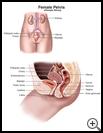
Pelvic Exam: Teen Version
________________________________________________________________________
KEY POINTS
- A pelvic exam is a checkup of your vulva, cervix, uterus, vagina, ovaries, and fallopian tubes.
- A pelvic exam may be done to check for growths, cysts, infection, or abnormal changes in cells that could be cancer.
- If you are having a Pap test when you have a pelvic exam, try to schedule the exam when you will not be having your period. These exams are usually not done during your period.
________________________________________________________________________
What is a pelvic exam?
A pelvic exam is a checkup of your vulva, cervix, uterus, vagina, ovaries, and fallopian tubes.
- The vulva is the outer part of your genitals. It includes the skin around the opening of the vagina (birth canal) and urethra (where urine leaves your body).
- The cervix is the opening of the uterus into the vagina.
- The uterus is the muscular organ at the top of the vagina. Babies develop in the uterus and pass through the vagina when they are born. Menstrual blood forms in the uterus each month and flows out of the vagina during your period.
- The ovaries are glands on either side of the uterus in your lower belly. Before menopause, the ovaries produce eggs.
- The fallopian tubes carry the eggs from the ovaries to the uterus.
The tests that are done during your pelvic exam will depend on your needs. A Pap test may be done during a pelvic exam. It checks for abnormal changes in the cells of the cervix. Talk to your healthcare provider about how often you need to have a pelvic exam and a Pap test.
When is it used?
A pelvic exam may be done to check for:
- Normal development of the female organs
- Irritation or infection, including sexually transmitted diseases
- Abnormal changes in the cells of the cervix, including cells that could be cancer
- Growths in the uterus such as fibroids
- Ovarian cysts (fluid-filled sacs in or on an ovary)
Ask your healthcare provider to explain why you are having the exam and any risks.
How do I prepare for a pelvic exam?
- If you are having a Pap test when you have a pelvic exam, try to schedule the exam when you will not be having your period. These exams are usually not done during your period.
- Your healthcare provider may recommend that you do not douche, use vaginal creams or ointments, or have sex for a few days before the exam.
- Ask any questions you have before the procedure. You should understand what your healthcare provider is going to do. You have the right to make decisions about your healthcare and to give permission for any tests or procedures.
What happens during the exam?
Just before the exam, you should empty your bladder. You will take off your clothes and put on a gown. A cloth will be draped over the lower part of your body. You will lie on your back on the exam table with your knees bent and the heels of your feet in stirrup heel holders. You will be asked to slide your hips to the end of the table and let your knees tilt to each side so that your legs are spread apart.
The pelvic exam takes only a few minutes. Your healthcare provider will check for any swelling, sores, or warts on your vulva. Then he or she will gently put a thin, lubricated tool called a speculum into your vagina. The speculum holds open the walls of the vagina so your provider can see the cervix. You may feel some discomfort in your lower belly and vagina during the exam. Try to stay relaxed and to breathe slowly and deeply. This will help keep your muscles relaxed and make it easier for your provider to do the exam.
If you have a Pap test during the exam, your healthcare provider will use a tiny brush to collect cells from your cervix. The cells will be examined in the lab. A sample of vaginal discharge may also be tested in the lab. After the samples are taken your provider will remove the speculum.
Your healthcare provider will then put 1 or 2 lubricated, gloved fingers in your vagina and a hand on your belly to feel the size and shape of your organs. This may not be comfortable, but it is usually not painful.
Your provider may also put a finger in your rectum to check for lumps or other problems.
What happens after the exam?
Your healthcare provider may ask questions about sex, menstrual periods, birth control, or hormone problems that are related to the results of your exam.
What are the risks of this procedure?
Every procedure or treatment has risks. Rarely, you may have an infection or bleeding. Ask your healthcare provider how these risks apply to you. Be sure to discuss any other questions or concerns that you may have.
Last modified: 2019-02-12
Last reviewed: 2018-08-03

